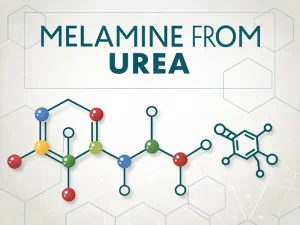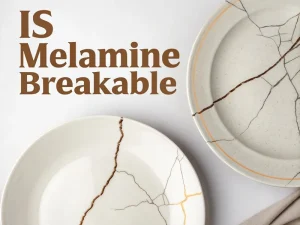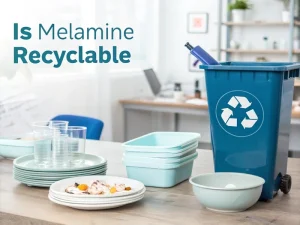
Melamine From Urea
Tech Blog melamine from urea Melamine is well-known for its wide range of applications, but its raw material for production is surprisingly urea. For manufacturers,

Melamine-based products—from durable tableware to scratch-resistant laminates—are widely used in household and industrial settings due to their heat resistance, hardness, and affordability. Especially when you look around the kitchen, you may find some tableware made of melamine—those lightweight, durable, brightly colored plates, bowls, and cups that look like plastic but feel harder and more ceramic-like.
This naturally raises an important environmental issue: Is melamine recyclable?
The short answer is: no, in the vast majority of cases, melamine products cannot be recycled through conventional home recycling systems.
It cannot be thrown into your recyclable bin like PET plastic bottles or glass jars. This article will provide an in-depth explanation of why this is the case, how to dispose of waste properly, and the more environmentally friendly options.
To understand the recyclability of melamine, it is necessary first to clarify the essence of the core material:
Melamine: a nitrogen-rich organic compound, with pure substance as white crystalline powder.
Melamine formaldehyde (MF) resin: the core raw material for the vast majority of consumer goods. It is generated by the reaction of melamine and formaldehyde, and forms a rigid cross-linked polymer through a thermosetting process. Once cured, this resin will irreversibly harden—unlike thermoplastic materials such as PET and HDPE, which cannot be reshaped by heating and melting.
No, melamine formaldehyde resin cannot be widely recycled through standard municipal recycling projects.
The core reason lies in its chemical structure: MF resin is a thermosetting plastic. When heated, thermosetting plastics do not melt; instead, they decompose or burn. This is in stark contrast to thermoplastic materials such as plastic bottles and yogurt cups, which soften and flow when heated, making them easier to melt, reprocess, and reuse.
In short, melamine’s durability (a core characteristic that makes it a practical material) makes it difficult to process through recycling methods suitable for most plastics.
The cross-linking molecular structure of MF resin is the biggest obstacle to recycling. During the production process, melamine and formaldehyde form strong covalent bonds in a three-dimensional network, which cannot be destroyed solely by heating. High temperatures can cause materials to carbonize, release toxic gases (such as formaldehyde), or break into brittle particles that cannot be reprocessed into new products.
Melamine powder products usually add other materials, such as pigments, cellulose fillers, or coatings, to enhance color, texture, or strength. These additives make recycling complicated:
Pollute recycled materials and reduce product quality;
Separation is costly, and large-scale recycling offers little economic benefit.
Even if technological barriers are overcome, recycling institutions lack the motivation to handle melamine:
No standardized recycling channels: Unlike PET (No. 1 plastic) or HDPE (No. 2 plastic), melamine lacks a unified resin identification code and is difficult to separate for recycling.
Low market value: The application scenarios for recycled melamine are limited (such as low-grade fillers), and its profitability is much lower than that of recycled thermoplastics.
Although large-scale recycling is not feasible, there are still some niche processes and initiatives:
In a controlled industrial environment, melamine waste (such as production scraps) can be ground into powder and mixed with the original resin in small amounts as a filler. Still, the proportion is usually limited to 10% or less. Although this method can reduce waste, it is not true recycling and still relies on new raw materials.
Researchers are exploring chemical methods to decompose MF resin cross-linking bonds using solvents or catalysts, thereby recovering melamine monomers for the production of new resins. But there are currently obvious limitations:
High energy consumption and high cost;
It will produce toxic by-products, such as formaldehyde, which must be handled with care.
It is still in the laboratory or pilot stage and has not yet achieved commercial scale application.
Melamine products at the end of their lifespan can sometimes be downgraded and recycled into low-value items, such as:
Building aggregates (mixed with concrete for non-load-bearing structures);
Fillers are used for artistic creation or landscape decoration.
This method can extend the service life of materials, but cannot form a closed-loop recycling system.
Melamine powder cannot be widely recycled through standard recycling projects due to its thermosetting structure, pollution risks, and inadequate infrastructure. Although experimental recycling methods exist, they have not yet been implemented on a large scale.
With the increasing demand for sustainable development, chemical recycling technology may make melamine recycling a reality in the future—but for now, prevention (choosing reusable and recyclable materials) remains the best environmental strategy.

Tech Blog melamine from urea Melamine is well-known for its wide range of applications, but its raw material for production is surprisingly urea. For manufacturers,

Tech Blog Is melamine breakable? When looking for tableware that is both aesthetically pleasing and durable, melamine (also known as melamine resin) products are often

Tech Blog Is melamine recyclable Melamine-based products—from durable tableware to scratch-resistant laminates—are widely used in household and industrial settings due to their heat resistance, hardness,

JINGJIANG MELAMINE POWDER
© JINJIANG MELAMINE